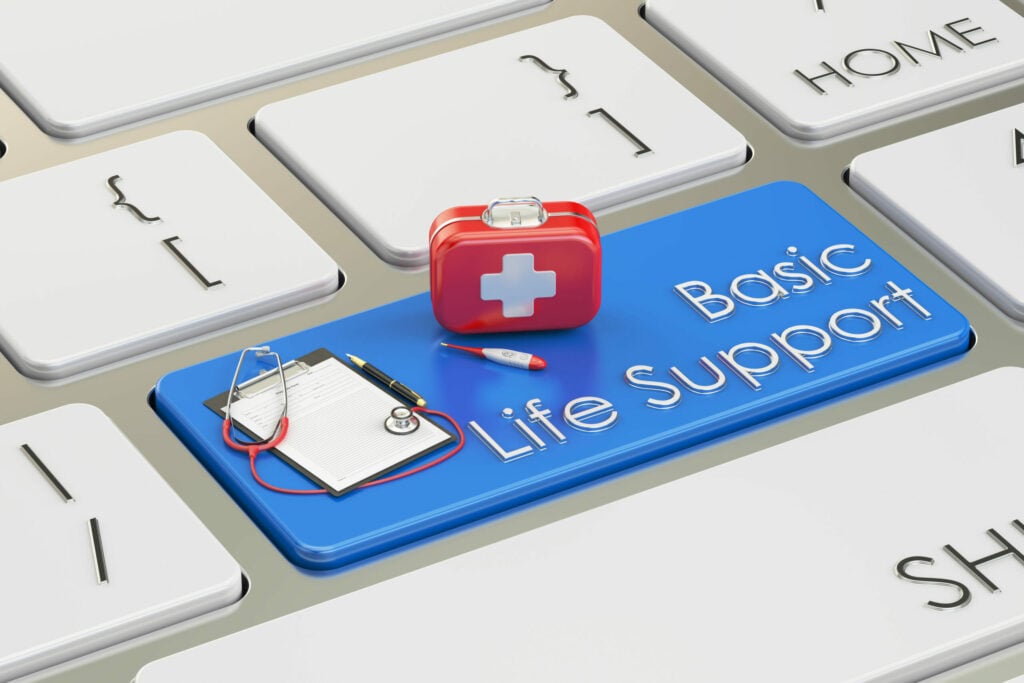
Last Updated On: September 23, 2024
The majority of people would probably say that they have never heard of Basic Life Support (BLS). However, most people have heard of CPR and have at least a fundamental grasp of what it entails. So, you may be surprised to learn that BLS and CPR share quite a few similarities; let’s find out how.
The American Red Cross defines BLS as the type of care provided by first responders, healthcare providers, and public safety professionals to people experiencing cardiac arrest, breathing difficulties, or an obstructed airway. It is necessary to have the information and abilities necessary to perform CPR, use automated external defibrillators (AED), and relieve airway obstructions in patients of all ages.
Even the most fundamental life-saving abilities aren’t that simple. Emergency cardiac care relies on these procedures, and they form the core of such treatment. In a BLS provider training, you will learn how to do single rescuer CPR, team CPR, choking relief, and AED operation for adults, children, and infants—all of the skills you need to revive unresponsive patients or administer emergency treatment.
BLS courses do not last for a whole semester like college or high school classes do. Within the confines of a two to four-hour in-classroom session, students will engage with interactive films, listen to lectures, and put their newly acquired knowledge into practice by doing several hands-on activities.
Bring a notepad with you when you practice so you can write down helpful hints and ideas. This will help you be better prepared for the written test. You will be guided through the process of saving a life by teachers who are either licensed medical professionals or persons who have received extensive training.
A BLS certification certifies that a person has received training in CPR and has exhibited a specified level of proficiency about the fundamental skills involved in giving CPR care to a person who is experiencing cardiac arrest.
As long as the act of rescue is done on a volunteer basis, having a BLS certification in the US does not grant authority to offer care nor does it indicate a responsibility to respond during an emergency situation.
The CPR certification is proof that the individual has been trained in CPR and has demonstrated a minimum level of competency throughout the duration of this course.
There is no guarantee that every course will be effective and consistent, even if the end certification is a card provided by a large national company. Even though accredited BLS certification is required to follow consistent and up-to-date guidelines set forth by the American Heart Association, there is no guarantee that every course will be accredited.
An educator could have the necessary credentials to educate a national curriculum in some circumstances, but they might not adhere to the guidelines for effective instruction. There is a possibility that the teacher will go off on irrelevant tangents or discuss personal medical experiences, both of which may not be the most efficient use of the available training time.
Instructors may arrive late to class, teach incorrect techniques, leave out parts of the training course, or simply fail to provide the essential knowledge and skills that students need to be able to perform CPR successfully. Because of these possible drawbacks, standardized and consistent training and testing with online BLS certification using a blended BLS format are gaining more and more popularity.
Teachers, coaches, personal trainers, childcare providers, and safety officials in various businesses are examples of people who probably do not require BLS certification but who do need some type of CPR training. In other words, they are individuals who typically do not provide emergency care as part of their professional responsibilities, but who may potentially find themselves in a situation in which they are accountable in the event of an emergency.
Moreover, training in BLS will instill in you the confidence to take decisive action when it is required; it has the potential to completely remove or significantly lessen any reluctance that you might have. You will have the confidence to know that you are performing the correct actions necessary to save a life since you will have received training in BLS.
In addition, having confidence will give you the ability to seize control of a situation and guide onlookers correctly when necessary. In a crisis, those who are on the scene can help onlookers by having them call 911.
Additionally, people will have more faith in your abilities as a trained expert who is able to aid them or their loved ones if you have BLS certification.
There are many accidents that might take place on a daily basis, any one of which can result in a major injury and cause a person to cease breathing.
These kinds of incidents call for prompt responses from persons who are informed and skilled enough to be of aid to those who are in need.
Register for ACCA’s BLS Course today!